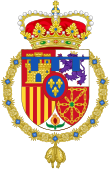
Back أمراء أستورياس Arabic امير استورياس ARZ Príncipe d'Asturies AST Прынц Астурыйскі Byelorussian Priñs Asturiez Breton Princ od Asturije BS Príncep d'Astúries Catalan Kníže z Asturie Czech Fyrste af Asturien Danish Fürst von Asturien German
| Princess of Asturias | |
|---|---|
| Príncipe de Asturias | |
 | |
 Standard of the princess | |
| Style | Her Royal Highness Doña |
| Residence | The Prince's Pavilion at the Zarzuela Palace |
| Appointer | The King of Spain |
| Inaugural holder | Henry III of Castile |
| Formation | 17 September 1388 |
| Website | www.casareal.es |
Prince or Princess of Asturias (Spanish: Príncipe/Princesa de Asturias) is the main substantive title used by the heir apparent, or heir presumptive to the Spanish Crown.[1] According to the Spanish Constitution of 1978:
Article 57.2: The Crown Prince, from the time of his birth or the event conferring this position upon him, shall hold the title of Prince of Asturias and the other titles traditionally held by the heir to the Crown of Spain.[2]
The title originated in 1388, when King John I of Castile granted the dignity – which included jurisdiction over the territory of Asturias[3] – to his first-born son Henry. In an attempt to end the dynastic struggle between the heirs of Kings Peter I and Henry II of Castile, the principality was chosen as the highest jurisdictional lordship the King could grant that had not yet been granted to anyone.[4] The custom of granting unique titles to royal heirs had already been in use in the Crown of Aragon (Prince of Girona) and the kingdoms of England (Prince of Wales), and France (Dauphin of Viennois).[5] The title, therefore, had two purposes: to serve as a generic title to name the heir apparent or heir presumptive, and as a specific title to apply to the prince who was first in the line of succession when the King transmitted to him the territory of the principality, with its government and its income.[4]
After the formation of the dynastic union between the Kingdoms of Castile and Aragon under the Catholic Monarchs, the title was favoured by the Spanish King, who by custom applied it in the same way, i.e. to his heir apparent. For generations the kingdom's crown prince accumulated the titles "Prince of Asturias, Girona, Spain and the New World", modifying those of the earlier regnant Habsburgs: "Prince of these Kingdoms, Prince of the Spains and the New World" (Príncipe de estos Reynos, príncipe de las Españas y del Nuevo Mundo).[6]
When the Bourbons acceded to the Spanish throne in 1705, the title was retained following the decisive help of Castile to the house in the War of the Spanish Succession.[7] At the beginning of the 19th century, the Spanish Constitution of 1812 (European year of revolutions) with consent of its counterparties ascribed the title to the heir of the Crown. The Constitutions within the following decades temporarily removed the synonymy between the title and position as heir to the Crown;[8] before being reinstated and recited in the second half of the 19th century, first half of the 20th century, and on the restoration of the monarchy (under parliamentary predominance) in 1978.[9][10]
- ^ Coronas González 2001, p. 49.
- ^ Constitución Española. Constitución española INGLÉS (PDF). Boletín Oficial del Estado, n° 311, 29 December 1978.
- ^ Suárez González 2000, p. 395.
- ^ a b Suárez González 2000, p. 394.
- ^ Coronas González 2001, p. 53.
- ^ Coronas González 2001, pp. 61–62.
- ^ Coronas González 2001, p. 64.
- ^ Coronas González 2001, pp. 67–68.
- ^ Coronas González 2001, p. 69.
- ^ Coronas González 2001, p. 73.
© MMXXIII Rich X Search. We shall prevail. All rights reserved. Rich X Search
